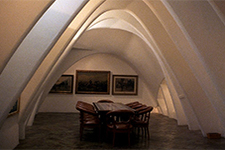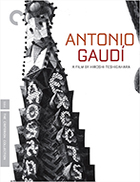Antonio Gaudí
|  You won’t learn a damn thing about the subject of Hiroshi Teshigahara’s documentary Antonio Gaudí. There are no talking head experts. No biographical backstory. No contemporary critics expounding on his work. Nothing about his life. Nothing about his death. No mention of the names of the buildings he designed or where they are located. Not even a single image of the man himself. But, by the time the film is over, you will be enthralled with his considerable architectural accomplishments, footage of which takes up the entirety of the film. Less a documentary than a poetic rumination on the enormity of Gaudí’s unique, unparalleled artistry, Teshigahara’s film is deceptively simple in its approach, yet rich in its effect. Working with cinematographers Junichi Segawa, Ryu Segawa, and Yoshikazu Yanagida, Teshigahara visually catalogs a dozen or so of Gaudí’s seminal works, all of which were designed and built in the late 19th and early 20th centuries in and around Barcelona. Sometimes he moves the camera into and through the spaces within Gaudí’s inimitable structures, and sometimes he creates a rhythmic montage of static shots that allow us to absorb and appreciate the intricacy and uniqueness of the Catalonian architect’s designs, which refuse to adhere to any school or pattern, but rather follow their own course. If you didn’t know the film was about a singular artist (as the title implies), you couldn’t be faulted for believing that you were looking at the works of a dozen different artists, all of whom defied convention. Yet, everything on the screen is the product of a singular imagination, one who saw buildings not as a collection of flat surfaces and right angles, but rather as a curvilinear flow of multi-varied surface textures that feels simultaneously ancient and modern. Some of his works you would swear are the ruins of an alien civilization, while others look like they might be the thesis project of a dedicated postmodernist. Wide shots give us some spatial context, and we see that many of his works are in the middle of large urban areas, but someone coming to the film cold might be surprised to learn that much of his work is not located in the Middle East. A dedicated Catholic whose faith informed much of his work, Gaudí (as I later learned) was referred to as “God’s architect,” a name that is most fitting when one considers his unfinished magnum opus, the Basílica de la Sagrada Família in the middle of Barcelona. A towering edifice of ornate spires that combines the Gothic and Art Nouveau, it is simply awe-inspiring in its aggressive grandiosity. At various points in the film Teshigahara turns his camera on the people who live and work in and around Gaudí’s buildings and therefore don’t notice them in an appreciable way anymore; they have simply become the background of their lives. Teshigahara, who first visited Spain in 1959 with his father, who was a sculptor, and was immediately captivated by the surreal, erotic power of Gaudí’s work, clearly wants us to see what they don’t, to revel in the enormity of his accomplishments. A graduate of the Tokyo National University of Fine Arts and Music, Teshigahara made his international name as an experimental art film director, earning acclaim in both his native Japan and in the U.S. and Europe for his gripping, ambiguous mind-bender Woman in the Dunes (1964). He got his start making documentaries, and it is a form to which he returned later in his career as a means of exploring other art forms (a few years earlier he made a short documentary about the Swiss sculptor Jean Tinguely). At its best, Antonio Gaudí reminds us of how powerful architecture can be—how it can move us and enthrall us and disarm us and we need not know a damn thing about it.
Copyright © 2020 James Kendrick Thoughts? E-mail James Kendrick All images copyright © The Criterion Collection | |||||||||||||||||||||||||||||
Overall Rating: 


 (3.5)
(3.5)


